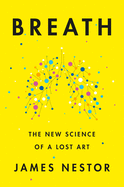
In Breath, journalist James Nestor (Deep) reveals how humans became the most inefficient breathers on earth, and how intentional changes could improve the quality of our lives.
As humans evolved and discovered new skills, our skulls changed to accommodate larger brains, but this came at a cost, leading to smaller mouths and noses. Along with agriculture and processed food that requires us to chew less, humans also developed crooked teeth, a thoroughly modern malady. We evolved to become smarter at the expense of our airways, which became restricted over time, and taking shallow, quick breaths through our mouths has become the norm. From snoring and sleep apnea to hypertension and anxiety, the way we breathe today is killing us.
But the good news is that we can change how we breathe. Some methods are achievable with practice: breathe through your nose; expand your diaphragm and exhale deeply; and achieve optimum breathing by taking fewer inhales and exhales (ideally 5.5 breaths per minute). Other techniques, from yoga traditions, are considered advanced today but were practiced by ancestors who understood breathing as instrumental to well-being.
Modern medicine pays little attention to the mechanics of breathing, so Nestor turns to the "pulmonauts" who have advanced our understanding of breathing's impact on health. Among these are Carl Stough, a choir conductor whose exhalation techniques dramatically improved the lives of emphysema sufferers, and Stanislav Grof, a Czech psychiatrist who employed heavy breathing to help patients achieve LSD-like enlightenment. With keen insight, thanks to Nestor's willingness to suffer through uncomfortable experiments, readers will assuredly pay closer attention to this essential yet overlooked bodily function. --Frank Brasile, librarian

